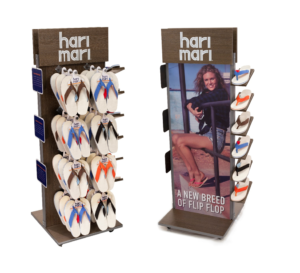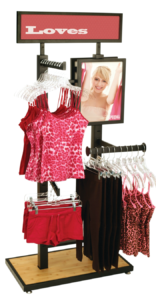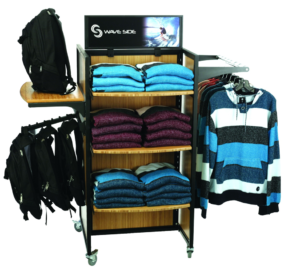The global apparel market exceeds $860 billion in annual sales. Apparel is big business and as long as people are wearing clothes, it isn’t going away any time soon. While retail sales in many product categories have lost share to eCommerce sales, apparel is one category where there are some limitations to the growth potential of eCommerce sales. Fit is important with many types of apparel so many shoppers like to try things on before making a purchase. In addition, a lot of people, particularly women, consider shopping fun, and they like to shop for clothing in physical retail stores. All of this points to the continued importance of merchandising and creating great retail apparel displays.
The Need for Flexible and Configurable Displays
Apparel is a fashion item which means that it is constantly changing and evolving. What that means for retail apparel displays is that in order to have a multi-year lifespan they must be flexible and configurable to be able to accommodate new lines of clothing, new styles, multiple sizes, and lots of SKUs.
Most of the retail apparel displays we make consist of a base unit and a set of accessories. This enables the retailer or brand to configure the display in a way that works for a given clothing assortment. The example shown below is our stock 4-WAY-EXT which is a 4-sided display consisting of a base with slotted metal uprights. It can be configured with straighouts, waterfalls, shelves, jetrails, cap pockets, and a header sign holder.

Some customers prefer a 2-sided configuration instead of a 4-sided display. Like the previous example, the display shown below has slotted uprights that provide a lot of flexibility for adjustable hanging components. Uscape Apparel configured this display with 2 waterfalls on each side which provides enough room for plenty of shirt inventory.

Nesting tables are another common type of apparel display. They are great for folded apparel items, mannequins, accessory items and decorations. Most nesting tables come in sets with 2 or 3 tables of varying heights that “nest” together. The picture below shows a 2-piece set we made with black metal frames and bamboo tops.
We offer a stock item called SFL-HRACK. It’s a mobile 4-sided fixture with a metal frame and slide-in panels. As with our other apparel display examples, it is highly configurable and works with numerous display accessories. Below it is shown with shelves, apparel bars, HBARS, faceouts, and a header sign holder, all of which combine to make an attractive, high-capacity apparel display.
Another example of a 2-WAY display is the Loves display shown below with straightouts, waterfalls, jetrails, a framed graphic, and a header sign.

Our SFL-HRACK can also be configured with bamboo panels and solid bamboo shelves. In the example below we added a waterfall, an apparel bar, and a header sign holder to create an upscale apparel fixture.

Not every retail apparel display needs to be a stocking display (i.e., that is, a display that holds inventory). The Cruel Girl Jeans apparel display shown below would be classified as a glorifier display. Glorifiers tend to showcase a single product or group of products but do not have inventory carrying capacity. Like the Cruel Girl Jeans display, they often have eye-catching graphics to catch shopper attention and create brand awareness.

Footwear is an important subcategory of apparel. Footwear is typically either displayed on shelves or hung if it is a product like flip flops or sandals. The 2-sided Hari Mari display below is a good example of a higher-end flip flop display with both shelves and hooks.

Like footwear, T-shirts are a popular apparel category. T-shirts are typically hung on hangers, folded, or sometimes rolled. The spinning T-shirt cubby display shown below is an effective merchandising approach because the T-shirt graphic is shown to the side of each cubby. Each of the 20 cubbies holds a dozen folded T-shirts, and the Guy Harvey header sign provides strong branding.

Our final example is the 5Fin multi-product apparel display shown below which features all-wood construction. The 2-sided display includes 10 cubbies for folded apparel items, a center shelf with a hang bar underneath, side graphics, and a dimensional header sign.


